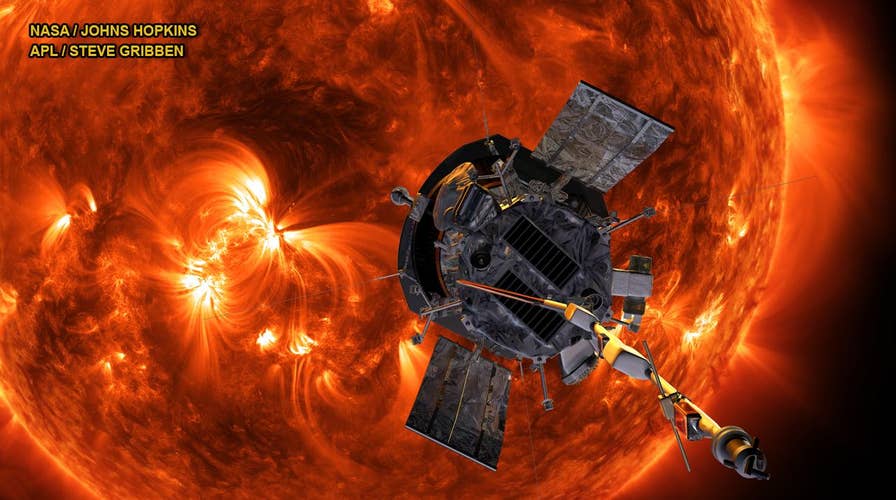NASA's Parker Solar Probe set to 'touch the Sun'
NASA is set to launch its Parker Solar Probe on a historic mission that will 'touch the Sun.' The solar probe will be the first spacecraft to fly through the Sun's corona, the outermost part of the star's atmosphere.
CAPE CANAVERAL – NASA’s Parker Solar Probe will soon blast off from Cape Canaveral Air Force Station on an epic journey that will see it dive through the outermost part of the Sun’s atmosphere.
The Parker launch window opens early Saturday. The $1.5 billion mission will take humanity closer to the Sun than ever before. Scientists have spent years devising technologies that will protect the car-sized spacecraft from instant incineration when it enters the Sun’s corona.
One of Parker’s key defenses is a white heat shield that deflects heat. “The heat shield is made out of a couple of different materials – one is carbon-carbon, which is a lot like the graphite epoxy you might see in your golf clubs or your tennis racket, but it has just been super heated,” explained Betsy Congdon, lead engineer for the heat shield at Johns Hopkins University’s Applied Physics Laboratory. “The inside is a carbon foam, which is just another kind of carbon and is actually about 97 percent air. It’s a very lightweight way of making a very strong structure.”
NASA'S PARKER SOLAR PROBE SET TO 'TOUCH THE SUN' ON HISTORIC MISSION
While the temperature of the Sun’s corona is a bewildering 2 million to 3 million degrees Fahrenheit, Parker will only have to deal with modest heat of nearly 2,500 degrees Fahrenheit. The Sun, like other stars, is made of plasma, and these plasma particles are quite spread out in the corona. This means that the solar probe will not be subjected to full force of the corona’s temperature.
As NASA explains, temperature and heat are two different things – while temperature is a measurement, heat is all about energy transfer. Because the plasma particles in the corona are fairly spread out, the amount of heat Parker has to deal with is significantly less than the region’s temperature.
“The corona and where we’re going is actually not that dense at all, there are only a couple of particles. When we think about it, those are very hot, but we’re not touching a lot of them,” said Congdon.
NASA'S PARKER SOLAR PROBE: CAPE CANAVERAL PREPARES FOR EPIC MISSION TO THE SUN
Circulating water will also be used to keep Parker’s solar panels from overheating. “Basically, water flows behind the solar arrays and into the radiators, so the water warms up when it is behind the solar cells and then cools down at the radiators, so that heat transfer is happening, a lot like the veins in your body,” Congdon explained.
Additionally, specialized software on the spacecraft will keep the heat shield pointing in the right direction. “We’re too far away to ‘joystick’ it into place, so it has to always be sensing if the heat shield is in the right position and correct itself if it isn’t,” Congdon said. “There are these things called solar limb sensors that are just poking out just at the very edge of the shadow – if those get illuminated the spacecraft knows ‘oh, I am going in the wrong direction’ and can actually right itself.”
With its solar defenses up and running, Parker’s instruments will be operating at room temperature.
NASA'S PARKER SOLAR PROBE SET TO WRITE NEW CHAPTER IN CAPE CANAVERAL HISTORY
Parker will blast off aboard a United Launch Alliance Delta IV Heavy rocket from Space Launch Complex 37 at Cape Canaveral Air Force Station, Fla. The 65-minute launch window for the mission opens at 3:33 a.m. EDT on Aug. 11, 2018.
Northrop Grumman is providing the rocket’s third stage. Ignition of the third stage is scheduled to occur 38 minutes and 58 seconds into the launch.
The spacecraft is scheduled to reach the Sun in November. Harnessing Venus’ gravity, Parker will complete seven flybys over seven years to gradually bring its orbit closer to the Sun. On its closest approach, the probe will be traveling at approximately 430,000 mph – a record for a manmade object.
SOLAR ECLIPSE, CRASHING SPACECRAFT, VOLCANOES AND MORE: BIGGEST SCIENCE STORIES OF 2017
On its closest flyby, in 2024, Parker will come within 3.8 million miles of the Sun’s surface. This is seven times closer than the previous closest spacecraft, Helios 2, which came within 27 million miles of the Sun in 1976.
The average distance between the Sun and Earth is 93 million miles.
The Sun’s corona, which can be seen during a total solar eclipse, is usually hidden by the bright light of the star’s surface. Scientists expect to glean valuable data from the mission, shedding new insight on the Sun’s potential to disrupt satellites and spacecraft, as well as electronics and communications on Earth.
NEW NASA PLANET HUNTER MAY FIND 10,000 ALIEN WORLDS IN JUST TWO YEARS
The government space agency hopes the probe will provide answers to what scientists describe as “the coronal heating problem.” One of the most unusual aspects of the Sun is that its atmosphere gets much hotter the farther it stretches from the star’s surface, according to NASA.
“Temperatures in the corona – the tenuous, outermost layer of the solar atmosphere – spike upwards of 2 million degrees Fahrenheit, while just 1,000 miles below, the underlying surface simmers at a balmy 10,000 F,” the space agency explains. “How the Sun manages this feat remains one of the greatest unanswered questions in astrophysics.”
Follow James Rogers on Twitter @jamesjrogers





















